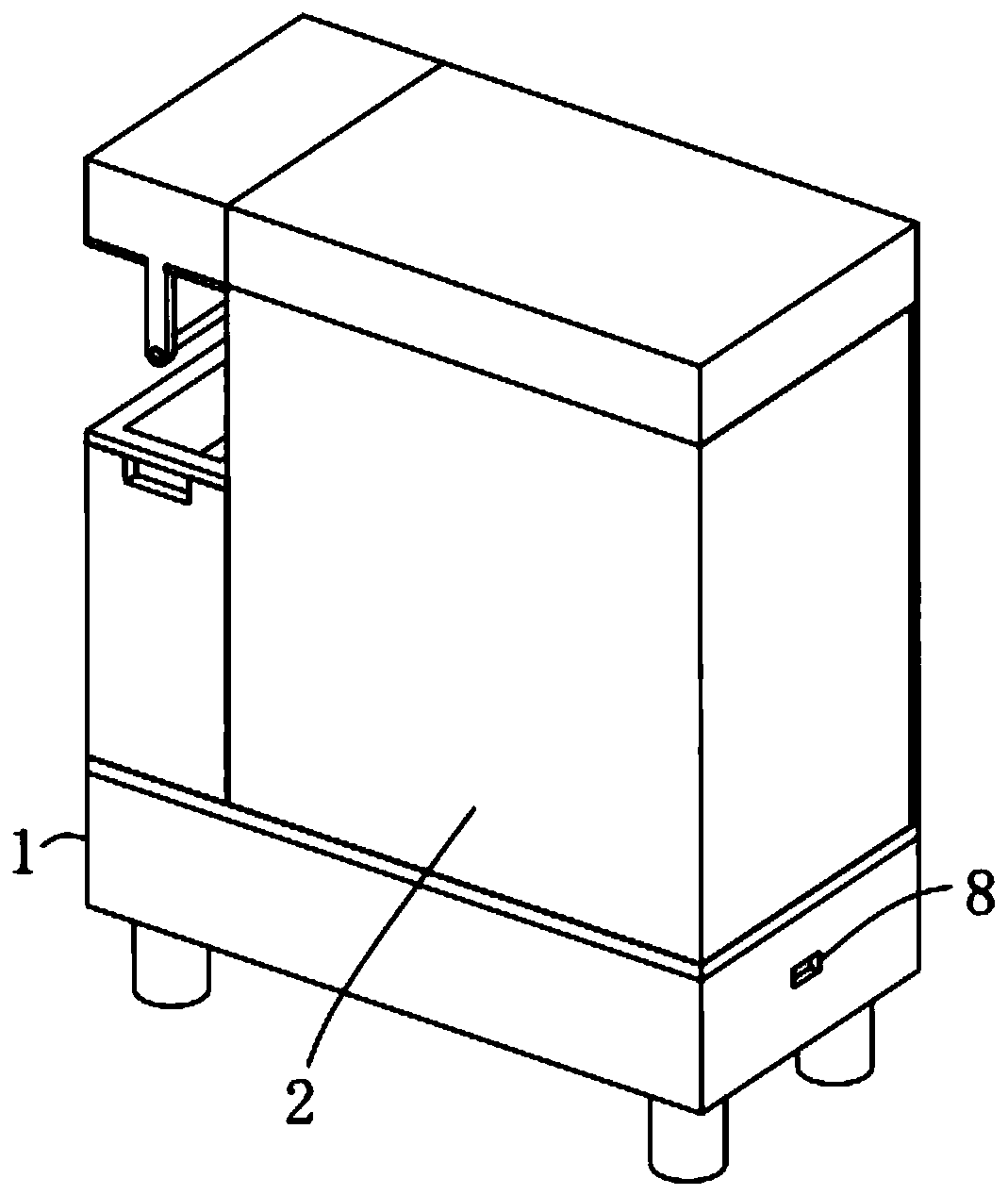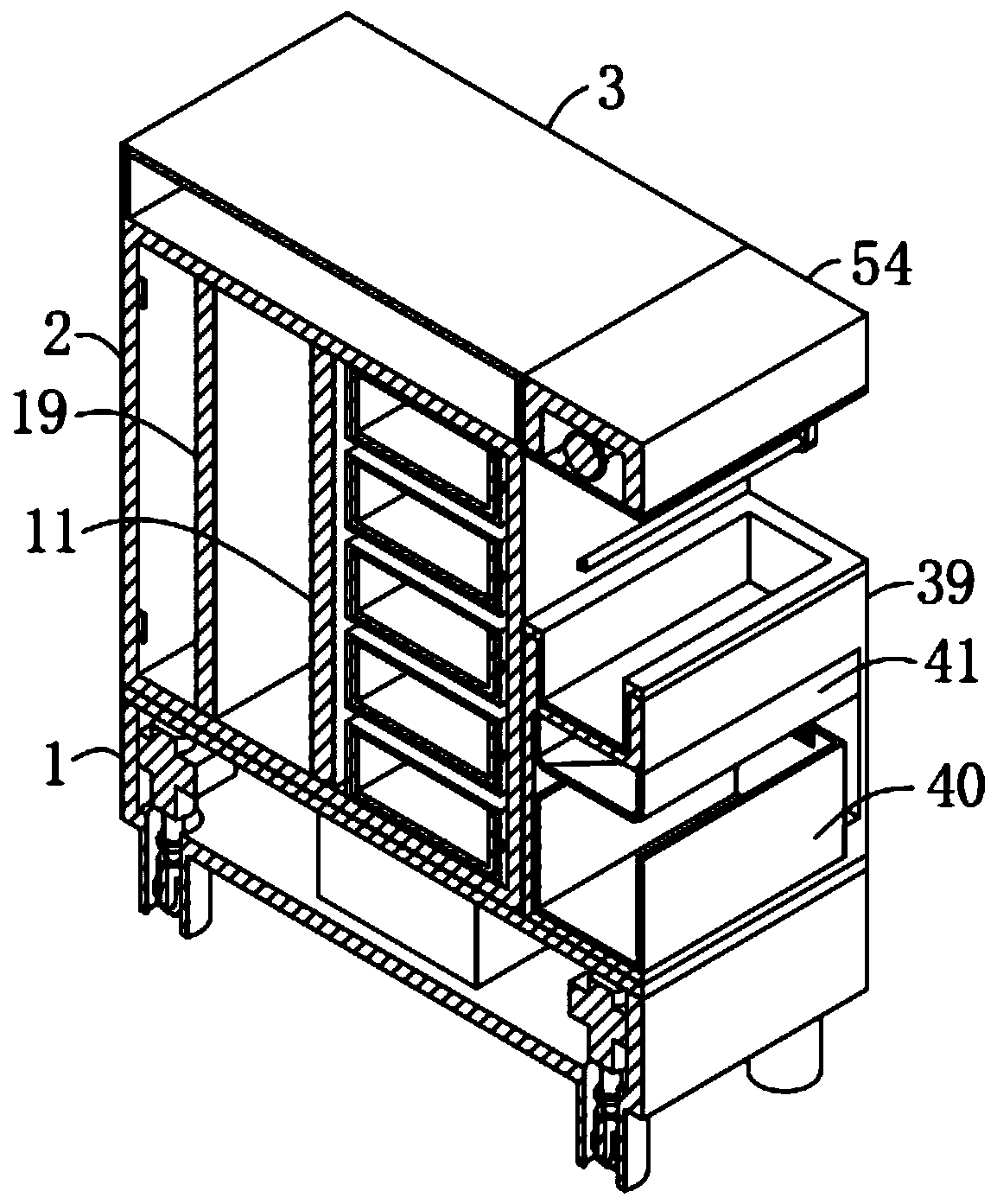Nursing cabinet for nursing of ICU patients
A technology for patients and wards, which is applied in the field of nursing cabinets for patient care in ICU wards, and can solve the problems of easy falling of nursing supplies, uncontrollable degree of clamping of nursing supplies, and dumping.
- Summary
- Abstract
- Description
- Claims
- Application Information
AI Technical Summary
Problems solved by technology
Method used
Image
Examples
Embodiment 1
[0064] A nursing cabinet for patient care in an ICU ward, such as figure 1 and 3 As shown in -7, it includes a base 1, a cabinet body 2, a clamping unit 13, and a storage unit 14. The base 1 is a hollow base, and an upper cover 34 is fixedly installed on the upper part of the base 1. The cabinet body 2 It is fixedly installed on the upper side of the upper cover plate 34, and the inside of the cabinet 2 is divided into a first storage room 9 and a second storage room 10 by a partition 11, and the outside of the first storage room 9 passes through The damping hinge 24 is hinged with the cabinet door 4, the clamping unit 13 is arranged inside the first storage chamber 9, and the storage unit 14 is arranged inside the second storage chamber 10;
[0065] Such as Figure 5-6 As shown, the clamping unit 13 includes a vertical plate 21, a splint 19, and a first electric push rod 23. Both the vertical plate 21 and the splint 19 are slidably installed inside the first storage chamber...
Embodiment 2
[0088] The difference from Example 1 is that the inner surface and the outer surface of the dustbin 40 are also provided with a protective layer, and the protective layer is prepared by the following method:
[0089] Take the following raw materials and weigh them by weight: 15 parts of epoxy resin, 8 parts of titanium dioxide powder, 12 parts of copper oxide powder, 13 parts of nano-silver powder, 7 parts of quartz powder, 12 parts of polytetrafluoroethylene, 10 parts of acrylic emulsion, alcohol ester 3 parts of twelve, 2 parts of triethanolamine, 1 part of emulsified silicone oil and 35 parts of water;
[0090] S1. Add the weighed acrylic emulsion, alcohol ester dodeca, triethanolamine, emulsified silicone oil and water into the mixer and stir for 20min at a stirring speed of 600r / min to prepare a mixed solution;
[0091] S2. Add epoxy resin, titanium dioxide powder, copper oxide powder, nano-silver powder, quartz powder and polytetrafluoroethylene into the pulverizer and p...
Embodiment 3
[0097] The difference with embodiment 2 is the preparation of protective layer, and its specific preparation method is as follows:
[0098] Take the following raw materials and weigh them by weight: 18 parts of epoxy resin, 10 parts of titanium dioxide powder, 11 parts of copper oxide powder, 15 parts of nano-silver powder, 9 parts of quartz powder, 15 parts of polytetrafluoroethylene, 12 parts of acrylic emulsion, alcohol ester Twelve 4 parts, triethanolamine 3 parts, emulsified silicone oil 2 parts and water 40 parts;
[0099] S1. Add the weighed acrylic emulsion, alcohol ester dodeca, triethanolamine, emulsified silicone oil and water into the mixer and stir for 25min at a stirring speed of 650r / min to prepare a mixed solution;
[0100] S2. Add epoxy resin, titanium dioxide powder, copper oxide powder, nano-silver powder, quartz powder and polytetrafluoroethylene into the pulverizer and pulverize until the particle diameter of the material is not greater than 100nm to obtai...
PUM
 Login to View More
Login to View More Abstract
Description
Claims
Application Information
 Login to View More
Login to View More - R&D
- Intellectual Property
- Life Sciences
- Materials
- Tech Scout
- Unparalleled Data Quality
- Higher Quality Content
- 60% Fewer Hallucinations
Browse by: Latest US Patents, China's latest patents, Technical Efficacy Thesaurus, Application Domain, Technology Topic, Popular Technical Reports.
© 2025 PatSnap. All rights reserved.Legal|Privacy policy|Modern Slavery Act Transparency Statement|Sitemap|About US| Contact US: help@patsnap.com



